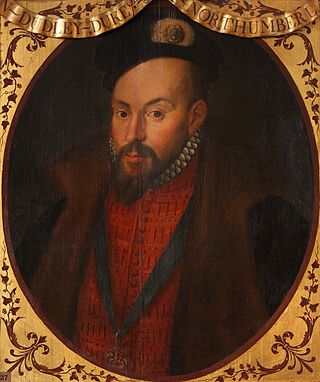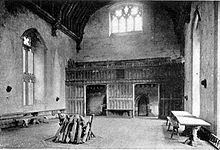
Yeoman is a noun originally referring either to one who owns and cultivates land or to the middle ranks of servants in an English royal or noble household. The term was first documented in mid-14th-century England. The 14th century also witnessed the rise of the yeoman longbow archer during the Hundred Years' War, and the yeoman outlaws celebrated in the Robin Hood ballads. Yeomen also joined the English Navy during the Hundred Years' War as seamen and archers. In the early 15th century, yeoman was the rank of chivalry between page and squire. By the late 17th century, yeoman became a rank in the Royal Navy for the common seamen who were in charge of ship's stores, such as foodstuffs, gunpowder, and sails.

The King's Body Guard of the Yeomen of the Guard is a bodyguard of the British monarch. The oldest British military corps still in existence, it was created by King Henry VII in 1485 after the Battle of Bosworth Field.

George Vertue was an English engraver and antiquary, whose notebooks on British art of the first half of the 18th century are a valuable source for the period.
Government in medieval monarchies generally comprised the king's companions, later becoming the Royal Household, from which the officers of state arose, initially having household and government duties. Later some of these officers became two: one serving state and one serving household. They were superseded by new officers, or were absorbed by existing officers. Many of the officers became hereditary and thus removed from practical operation of either the state or the household.

A chapel royal is an establishment in the British and Canadian royal households serving the spiritual needs of the sovereign and the royal family.

The Groom of the Stool was the most intimate of an English monarch's courtiers, responsible for assisting the king in excretion and hygiene.

The Year Books are the earliest law reports of England. This name for the later collections of these reports is of modern origin.

Weights and measures acts are acts of the British Parliament determining the regulation of weights and measures. It also refers to similar royal and parliamentary acts of the Kingdoms of England and Scotland and the medieval Welsh states. The earliest of these were originally untitled but were given descriptive glosses or titles based upon the monarch under whose reign they were promulgated. Several omnibus modern acts are entitled the Weights and Measures Act and are distinguished by the year of their enactment.

The Royal Households of the United Kingdom are the collective departments that support members of the British royal family. Many members of the royal family who undertake public duties have separate households. They vary considerably in size, from the large Royal Household that supports the sovereign to the household of the Prince and Princess of Wales, with fewer members.

John Gough Nichols (1806–1873) was an English painter and antiquary, the third generation in a family publishing business with strong connection to learned antiquarianism.

The Yeomen Warders of His Majesty's Royal Palace and Fortress the Tower of London, and Members of the Sovereign's Body Guard of the Yeoman Guard Extraordinary, popularly known as the Beefeaters, are ceremonial guardians of the Tower of London. In principle they are responsible for looking after any prisoners in the Tower and safeguarding the British crown jewels. They have also conducted guided tours of the Tower since the Victorian era.
Thomas Madox was a legal antiquary and historian, known for his publication and discussion of medieval records and charters; and in particular for his History of the Exchequer, tracing the administration and records of that branch of the state from the Norman Conquest to the time of Edward II. It became a standard work for the study of English medieval history. He held the office of historiographer royal from 1708 until his death.

The Statute of York was a 1322 Act of the Parliament of England that repealed the Ordinances of 1311 and prevented any similar provisions from being established. Academics argue over the actual impact of the bill, but general consensus is that it made the idea that the House of Commons should be consulted on all matters of general interest. The statute is seen as "the end of a period of revolutionary experiments in English government", with no Ordinances ever attempted again.
John Whitcomb Bayley was an English antiquary.
Sir Henry Seymour was an English landowner and MP, the brother of Jane Seymour, queen consort of Henry VIII, and consequently uncle to Edward VI. He was created a Knight of the Bath after his nephew's coronation.

An Esquire of the Body was a personal attendant and courtier to the Kings of England during the Late Middle Ages and the early modern period. The Knight of the Body was a related position, apparently sometimes merely an "Esquire" who had been knighted, as many were. The distinction between the two roles is not entirely clear, and probably shifted over time. The positions also existed in some lesser courts, such as that of the Prince of Wales.
Edmund Turnor, FRS, FSA, JP, was an English antiquarian, author, landowner and a British politician.
Craven Ord (1756–1832) was an English antiquarian. He was particularly noted for his brass rubbings.

John Fox (1611–1691) was Clerk of the Acatry to King Charles II, which below stairs department was responsible for meat destined for the royal tables. In 1660 the department comprised a clerk and a sergeant, appointed by royal warrant, a yeoman of the salt stores, yeomen and grooms, appointed by the Lord Steward's warrant.

The Yeoman Archer is a term applied specifically to English and Welsh military longbow archers of the 14th-15th centuries. Yeoman archers were commoners; free-born members of the social classes below the nobility and gentry. They were a product of the English form of feudalism in which the military duty of a knight to his lord was replaced by paid, short-term service. By negating the tactical advantage of large numbers of cavalry with their ability to rapidly fire volleys of arrows, Yeoman Archers are considered part of the Infantry Revolution of the 14th century. The Battles of Crécy and Agincourt are the best known victories of the Yeoman Archers.
















